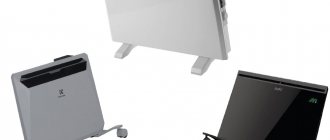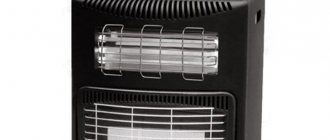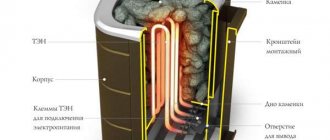| Place | Name | Characteristics in the rating |
| TOP 10 most economical convectors |
| 1 | Ballu BEC/EVU-2500 | The best choice |
| 2 | Electrolux ECH/AG2-2500 T | Most popular manufacturer |
| 3 | Timberk TEC.E3 E 2000 | The best ratio of price and quality |
| 4 | Ballu BEP/EXT-2000 | Attractive design |
| 5 | Polaris PCH 2089D | The most reliable device |
| 6 | TESY CN 03 200 EIS | Moisture-resistant housing |
| 7 | Atlantic F125 Design 2500W | Convenient programming modes |
| 8 | Stiebel Eltron CON 30 Premium | Powerful heater |
| 9 | Royal Clima REC-MP2000E Milano Plus Elettronico | Best price |
| 10 | Noirot Aurea Smart ECOcontrol | A lot of bells and whistles |
The heating convector is a brilliant invention. The principle of its operation is based on the law of physics, according to which hotter air always rises, and cold air, on the contrary, sinks to the floor. This device does not require a forced suction system. The air itself passes through the heater, rises to the ceiling and displaces unheated masses, and they, in turn, repeat this path.
Our rating considers exclusively electric models with the most economical energy consumption. With the same consumption, different convectors may show different results in terms of consumption. This is ensured by a number of factors:
- heater type;
- rated power;
- heat exchanger size;
- presence of a thermostat;
- possibility of manual and automatic power adjustment;
- additional functions.
An electric convector uses a heating element for heating. It can be open or monolithic. The second option is more preferable, as it lasts much longer - up to 20 years. The rated power is calculated using the formula 1 kilowatt per 10 square meters. But some models, due to increased efficiency, change this scheme in a more attractive direction. Various adjustment options also affect efficiency. Ideally, the device has fine tuning that allows you to set the parameters in the most energy-saving mode.
Convector rating
When compiling the rating, reviews of real people and the opinions of experts who selected the nominees were taken as a basis. Testing was also carried out, which helped to identify the advantages and disadvantages of thermal equipment. When selecting participants for the TOP, the following criteria were taken into account:
- Device type;
- Quality of materials;
- Safety;
- Thermal power;
- Heat source;
- Heating area;
- Installation method;
- Thermostat;
- Price.
Analyzing the listed properties and conducting thorough tests, experts selected the best convectors from the 2021 models. Another condition for inclusion in the TOP was the ratio of price and quality.
The best pumps to increase water pressure
Conclusions and useful video on the topic
The video contains material about the criteria according to which a high-quality electric heating convector is selected, as well as information about the most popular brands:
Modern models of electric convectors allow us to solve the problem of maintaining a comfortable temperature in the rooms. A properly selected device combines fast heating time, high power and energy-saving technologies, as well as ease of use.
Are you looking for an electric convector model, but can’t make a choice? Or have you been using such a heating device for a long time and can share your impressions of its use? Please leave comments, ask questions, and share your experience in the block below the article.
Types of thermostats
One of the main elements of any electric convector is a built-in thermostat, which allows you to set the required temperature in the room. The thermostat control can be:
- electronic;
- mechanical.
If the thermal regulator is mechanical, then adjustment is carried out by turning the step switch. Its main advantage is its low cost. Among the disadvantages are:
- inability to set the exact temperature;
- increased consumption of electrical energy.
An electronic thermostat is much more practical in this matter. With its help, you can easily set the required temperature, this device is almost silent, and it uses electricity efficiently. Convectors with this type of thermostat are more expensive, but hardly anyone will dispute their advantages.
The best electric wall convectors
Such models are mounted to the wall using a bracket or screws. This type of mounting is convenient for standard window heights, and the dimensions of wall-mounted convectors make it easy to place them under the window sill. You can buy a wall-mounted electric convector in household and electrical appliance stores, or you can also place an order online. This category presents four models that beat out dozens of contenders to get into the TOP.
Noirot Spot E-5 2000
A simple electric heating convector, operating on the principle of natural convection, is capable of heating a room up to 25 sq/m and has a power of 2000 W. This model has a strict, unremarkable design; it looks like a standard radiator section, so it looks inconspicuous under the window. Noirot Spot E- is equipped with a small LCD display that shows the temperature of the heated room. The control is touch-sensitive, electronic, the device has 4 automatic operating modes, adapted to different temperatures. Also, Sport-E has small legs that allow you to rearrange the device if necessary.
Advantages
- Frost protection;
- Quiet operation;
- Quickly heats the stated area;
- Long power cord;
- Nice build.
Flaws
- Heavy;
- Rollers need to be purchased separately.
In general, reviews of Noirot heating convectors are quite flattering; buyers use these models for heating garages, vegetable stores, and summer cottages. No one considers even a relatively high price a disadvantage, since it corresponds to the quality of the device.
Stiebel Eltron CNS 150 S
This model is compact in size and has fairly high power (1500 W). It is designed for a room up to 25 sq/m and has simple mechanical controls. The convector is attached to the wall with a bracket; it can be used as a main or additional heater. The built-in thermostat ensures that the set temperature is maintained, and two automatic modes allow you to set operating parameters. The case is protected from frost, plus the Stiebel Eltron has a built-in relay that automatically trips when overheating or a power surge.
Advantages
- Waterproof housing;
- Long warranty period;
- Non-yellowing surface;
- Stainless steel heating element;
- Small price.
Flaws
- There are no supporting legs;
- There is no auto shut off option.
Unfortunately, the manufacturer did not provide an auto-shut-off function in the CNS 150 S, so the device will heat the air until the user turns it off.
Electrolux ECH/R-2500 T
Users like the stylish and powerful wall-mounted electric heating convector from Electrolux. It has a modern design, high power (2500 W) and quite a lot of functionality that allows you to use the device comfortably. Electrolux is capable of heating a room of up to 30 sq/m, while its weight and dimensions are small. The convector has several power modes; it can be installed on a wall or on the floor, thanks to its small but stable legs. This model is also distinguished by the presence of a solid heating element, which provides a large heat transfer area and instant heating.
Advantages
- Master Speed Heating system;
- Fall protection;
- Enlarged air intake;
- Removable control unit;
- Light weight.
Flaws
- Quite a lot of energy consumption;
- There is no moisture protection.
It is noteworthy that the control units for this model can be selected separately; they are presented in three versions. Among them there is an element with a Wi-Fi module, a simple mechanical or inverter unit.
Timberk TEC.E3 M 2000
Relatively simple, but very reliable heater. The assembly is quite strong, the body is made of light metal, plus it is possible to install the convector on rollers (included in the kit). The power of the device can be adjusted (from 850 to 2000 W). The control is mechanical and operates in only one mode, but the temperature can be set independently. If the device overheats, it automatically turns off, and the case is protected from moisture, so you don’t have to worry about a short circuit if liquid gets in. Separately, buyers praise the quiet operation and the absence of foreign odors.
Advantages
- Fast heating;
- Economical energy consumption;
- Built-in thermostat;
- Full operation indication;
- Thick, long power cord.
Flaws
- When heating and cooling, clicking sounds are heard.
Buyers call Timberk the best electric convector for the garden and home, because despite all its positive parameters, it has minor drawbacks.
Plus, the price of this model is relatively low, and its quality is not inferior to popular European brands.
Key differences
The main difference between these two heating devices is that the radiator increases the temperature in the room by heating its own body. The convector provides circulation, passes air through itself and heats it, which allows you to quickly heat the room.
Among other distinctive features, we can note the fact that the efficiency of the convector is much higher, in most cases it is close to 100%.
The wall convector is very convenient to install; it takes up minimal space. The average service life of a convector is 20 years .
The only advantage of a radiator is its price, which is slightly lower than a convector, but sometimes quality is much more important than money.
Convector or standard oil heater?
Take a look at the comparison chart in this review article >>>
Selecting the optimal equipment power
The choice of convector power is made according to a very simple formula: to heat 1 m2 of room you need to spend 100 W of power. The resulting power must be increased one and a half to two times with ceiling heights over 2.5 meters . If the convector is used as an additional heating source, the power is reduced by 1.5 times.
| Device power, kW | Room area, m2 |
| 1000 | 10 |
| 1200 | 12 |
| 1500 | 15 |
| 2000 | 20 |
| 2500 | 25 |
Economic feasibility of purchasing a convector powered by electricity
- for heating a country house where there is no possibility of using gas networks;
- in apartments as the main or additional type of heating;
- shopping pavilions and tents where there is no other way to warm up during the cold season.
As practice shows, heating one square meter using an electric convector costs about 7 - 10 dollars per year. Thanks to the ability to adjust the temperature, you can save up to 40-80% of electrical energy, depending on the degree of use of your living space.










